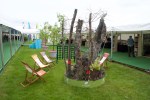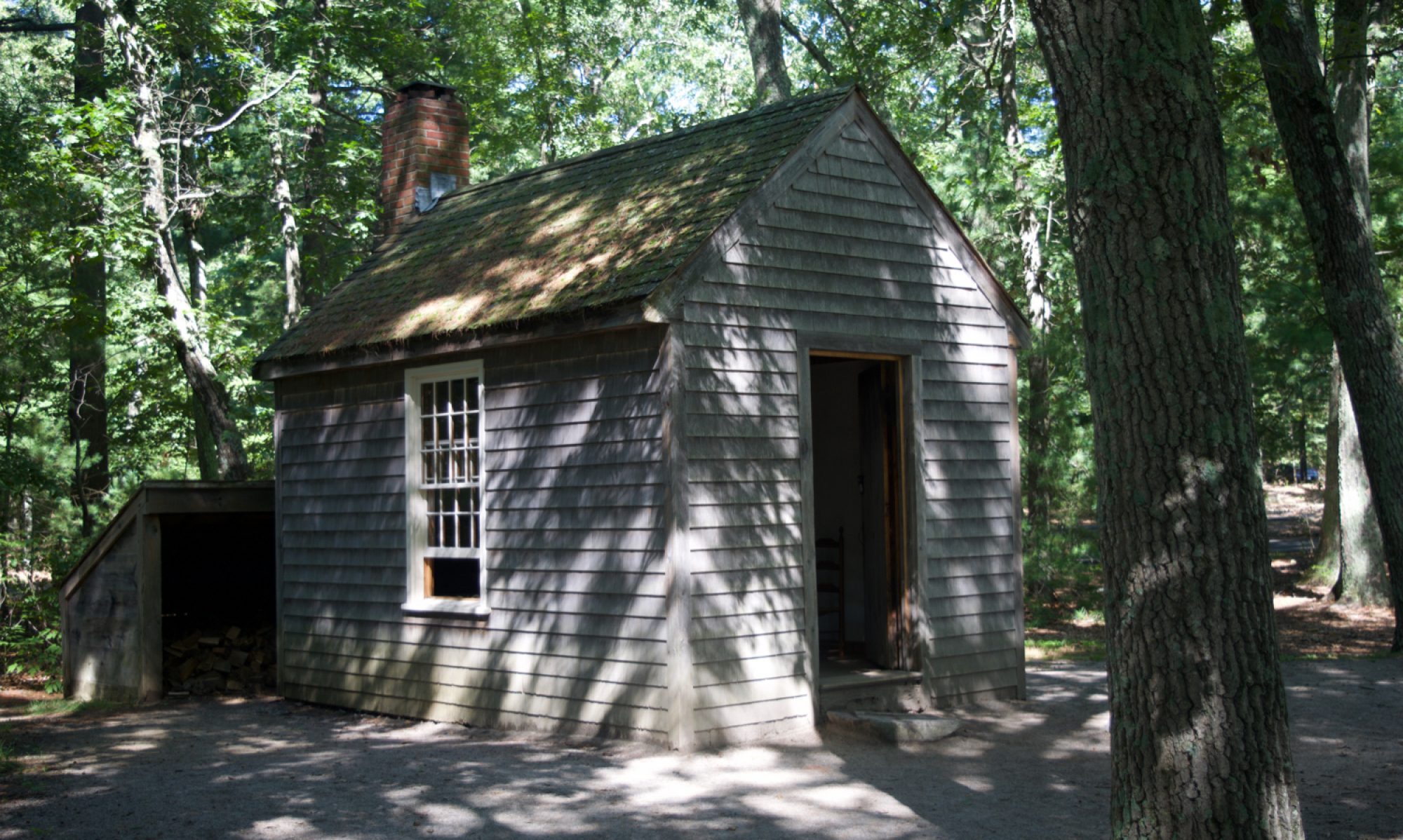Yesterday I was at the Hay Festival and went to sessions about rewilding and permaculture. This was my first time at the festival, although I’ve been going to Hay-on-Wye’s second hand bookshops since I was young. The annual book festival is about ten days long and takes place in tents and covered walkways in a field outside of town. There is an official book shop and some stalls, but it’s mostly discussion sessions and talks. Some of these are plugging someone’s new book, but others are about other interesting topics.
 After a bit of an explore, the first session I went to was also the first of the festival and was entitled
After a bit of an explore, the first session I went to was also the first of the festival and was entitled
“Elements of re-wilding: perceptions and prejudices”. It took the form of a panel discussion led by Rob Yorke, with Sophie Wynne-Jones of Wales Wild Land Foundation and Bangor University, Julia Aglionby of the Foundation for Common Land (i.e. land with commoners who have a right to use it), and Minette Batters the deputy president of the National Farmers’ Union.
I’m interested in rewilding for several reasons. It includes reforesting land. The likely missing, native species we’re talking about have intrinsic value, like restoring a painted-over fresco. Keystone species can dramatically improve natural checks and balances, such as beavers building dams which mitigate flash floods downstream. Three species may be significantly reduced which are bad for saplings and suppress the natural regeneration of native trees from seed, either in re-established forests or to replace felling in existing woods: pine martens control grey squirrel numbers, and lynx control deer and rabbits. Rewilding moves the British landscapes closer to their naturally wooded state, which people will engage with more, and start to rewild ourselves. I believe more basic “accommodation” like wild camping and hutting have a role in that.
Rob Yorke had a list of prepared topics to provoke discussion, and started with definitions of rewilding, and then things moved on to differing land uses, environmental benefits such as flood control, climate change, and even the EU referendum. One theme that kept being emphasised was the desirability of avoiding conflict and trying to find consensus, rather than the sometimes stronger language that you see. I had a feeling that phrases such as George Monbiot’s “White Plague” description of the impact of sheep on the landscape were in people’s minds when saying this.
Consensus and compromise are good, but they are a two-way process, and it became increasingly clear that Minette Batters and Julia Aglionby were dragging us away from rewilding step by step. Eventually the idea of reintroducing pine martens for their own sake and for the way they suppress grey but not red squirrels was countered by the idea that we might just not bother and be satisfied with conserving the refuges the reds have been reduced to.
Simultaneously, farmers had to be acknowledged as the custodians of the landscape who take a multi-generational view in contrast to politicians and the public; and yet the 25 years for tree planting to take full effect could be deployed dismissively when discounting trees for flood control. Consistently, the message was “management”. A managed landscape that must continue to be managed. It’s understandable that people whose uneconomic lifestyle is subsidised by the more productive elements of the economy in return for “management” of the landscape are attached to the word. But it’s missing the point in a discussion about rewilding, where the intent is to see how far we can let go.
The discussion took a more worrying turn when Minette Batters got on to the subject of lynx. She’s clearly horrified by the idea, and the thought they might take lambs, and deployed some unfortunate and untrue arguments. In particular, she claimed that “we” had decided to remove lynx from Britain because they are dangerous to people (and to the aforementioned lambs.) This was picked up by the Telegraph reporter present (or planted by the NFU?) with the lurid headline “Releasing lynx into wild puts ramblers in danger of attack, warns NFU“.
I’m struggling to believe that Minette Batters is ignorant of the European experience with lynx. Humans aren’t attacked by lynx. If you attack a lynx it will defend itself, but they actively avoid humans. The whole idea was implicitly undermined elsewhere in the discussion: we weren’t even to consider lynx as a way of controlling badger numbers (which are crashing the hedgehog population) because there was no way a lynx could tackle a badger.
In retrospect I should have made more of an effort to get the audience microphone and object to the falsehood that lynx endanger humans before the discussion moved on. But it illustrates that an untrue statement can conveniently shut down a debate in the moment, and then get spread by other media to a wider audience (with comments turned off, too.) People do say some very harsh things about the NFU’s behaviour, and this is the first time I’ve seen it up close. Unfortunately Minette Batters is ignoring replies to her comment via Twitter, despite happily tweeting away about other things.
So all in all I felt it was a wasted opportunity to really get into the subject of rewilding, and that being nice and trying to find a consensus doesn’t work when this kind of thing is going on in the room.
Next I went to “Permaculture and climate change adaptation” with Thomas Henfrey (who has a new book out), Maddy Harland and Andy Fryers. There were some interesting overlaps with rewilding. One striking example was the Tamara village in Portugal where reforestation was part of improvements in water availability throughout the year, where previously cork oaks had been replaced by eucalyptus, accompanied by a collapse of lynx numbers incidentally. Permaculture shares with rewilding a recognition of natural systems and the way their elements fit together and cannot be broken down into separate parts and controlled.

 Back outside, the Woodland Trust have a stand at this year’s festival, and were fielding waves of children from the school coach trips that had been organised, in between the sessions they all seemed to disappear in to every hour or so.
Back outside, the Woodland Trust have a stand at this year’s festival, and were fielding waves of children from the school coach trips that had been organised, in between the sessions they all seemed to disappear in to every hour or so.
 Hay is normally a different kind of town anyway, and the festival accentuates this. On the road between the town and the festival field, ad-hoc cafes and shops pop up, like this one in a front garden. There’s also a convenient car park next to the festival run for Macmillan, which you can pre-book.
Hay is normally a different kind of town anyway, and the festival accentuates this. On the road between the town and the festival field, ad-hoc cafes and shops pop up, like this one in a front garden. There’s also a convenient car park next to the festival run for Macmillan, which you can pre-book.


 The weekly market in front of the castle still goes ahead, now in the hands of the Hay Castle Trust after it was sold by Richard Booth, who started Hay on the path to becoming a “book town”. His old bookshop is now in other hands, but he started again with the much smaller “Richard King of Hay” bookshop.
The weekly market in front of the castle still goes ahead, now in the hands of the Hay Castle Trust after it was sold by Richard Booth, who started Hay on the path to becoming a “book town”. His old bookshop is now in other hands, but he started again with the much smaller “Richard King of Hay” bookshop.
There are fewer shops than there used to be, and I’m guessing that’s the internet. I used to scour second hand bookshops but now use sites like Abebooks.com if there’s something out of print I need. Searching rather than browsing I suppose you could say. However, just as vinyl records have survived despite cassettes, CDs, DAT, MD, MP3s, and now streaming, people still enjoy the experience of browsing and reading physical books.
 This last photo is taken from Hay Bridge, showing the wooded banks which include the Wye Valley Walk. Across the bridge is the main site of the How the Light Gets In festival which runs at the same time as Hay Festival itself. They have a helter skelter and a big wheel (amongst other things) though.
This last photo is taken from Hay Bridge, showing the wooded banks which include the Wye Valley Walk. Across the bridge is the main site of the How the Light Gets In festival which runs at the same time as Hay Festival itself. They have a helter skelter and a big wheel (amongst other things) though.
Sun 29th May update: Ben Eagle has posted another first hand account of the rewilding panel at Hay. Minette Batters of the NFU still hasn’t retracted (or defended!) her falsehoods about lynx.
Thu 2nd June: another first hand account (“What would Eat a Badger? Rewilding at the Hay Festival“), from Graham Strouts at Bangor.
 William Wordsworth lived in the house in 1808-10, and while he condemned its exterior, he loved its views over Grasmere and up to the surrounding hills and mountains. You can see Grasmere in this picture, along with some of those paints I mentioned. There’s plenty of paper too.
William Wordsworth lived in the house in 1808-10, and while he condemned its exterior, he loved its views over Grasmere and up to the surrounding hills and mountains. You can see Grasmere in this picture, along with some of those paints I mentioned. There’s plenty of paper too.






























 Paul walks along the beach in front of the huts, and talks to Jack of the Lobster Pot. Just like we did when we visited the site. In fact, just like lots of other people have since Jack is a friendly guy who strikes up conversations with passersby, and is a mine of information about the huts and life right on the edge of the land.
Paul walks along the beach in front of the huts, and talks to Jack of the Lobster Pot. Just like we did when we visited the site. In fact, just like lots of other people have since Jack is a friendly guy who strikes up conversations with passersby, and is a mine of information about the huts and life right on the edge of the land.























































































